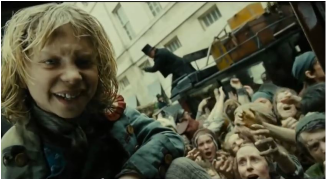 A boy sings to the rich about the plight of the poor. A boy sings to the rich about the plight of the poor.
Tags: capitalism, class, economic sociology, inequality, marx/marxism, political economy, theory, class consciousness, class conflict, 00 to 05 mins
Year: 2012 Length: 2:48 Access: YouTube Summary: This clip from the 2012 film of the musical Les Misérables begins by showing beggars and urchins pressing against the carriages of the rich, begging for food or money. Gavroche, the lead urchin, explains to the audience the political situation in France (in 1832) and then joins a crowd of people expressing their anger at the situation so many of them are in. For the most part, the classes are polarized binto the rich and the poor (lower and upper classes). Particularly in the case of the working class, there seems to be minimal gap between their actual needs and experiences and their attitudes toward their situation. The scene and its accompanying song reflect key concepts in much of Marx and Engels' Manifesto of the Communist Party. For example, it illustrates the lower class's class consciousness, as both their objective class position and subjective consciousnesses are aligned; they realize their own position in the class system and how it affects them. As noted by Marx and Engels, the poor can “live only so long as they find work, and who [can] find work only so long as their labour increases capital” and are therefore wholly dependent on the upper class for their livelihood. However, the upper class is not acting in the interests of these poor, and the leaders that could make decisions to the benefit of the poor are absent and unhelpful. Therefore, the only people that can act in the interests of the lower class are the poor themselves. In order to live the life they want to live, the poor need to rise up collectively and make the necessary changes in the system. As this collective action is “continually being upset again by…the workers themselves” (Marx), the young men function to facilitate the inevitable conflict with the upper class. When Gavroche explains the continuous political loop the people have been in, finding themselves struggling again after seeming to have fixed the problem, he demonstrates the idea that class struggle is continuous and, according to Marx, present in “the history of all hitherto existing society.” With this understanding of the sociological factors in play in this clip, the viewers can make connections between the clip, albeit fictional, and other instances of class conflict throughout history. It is a strong representation of the differences between different classes and the consciousness that leads to conflict and change. Submitted By: Kiersten Payne
4 Comments
 A vintage video game is used to discuss Marxism. A vintage video game is used to discuss Marxism. Tags: capitalism, class, economic sociology, marx/marxism, political economy, theory, alienation, dialectical materialism, philosophy, subtitles/CC, 00 to 05 mins Year: 2014 Length: 3:51 Access: YouTube Summary: This video is part of a series of 8-bit Philosophy, which seeks to “communicate even the most complex of philosophical concepts in a fun, easy-to-understand way.” It uses vintage video games (from the original Nintendo) to explain complex philosophical ideas. Using quotes from The German Ideology and other works, with altered scenes from Super Mario Brothers, the narrator explains several concepts within Marxist theory. For example, the narrator explains that Marx argued it was not ideas that drive historical change, but "it is our conflict arising out of our relation to material goods" that shapes history. This process of historical materialism is explained in terms of the economic systems and social relations of a society; it is simultaneously illustrated using a character from the video game (Toad) and its weapons (a turnip) that reflect commodities that the character produces. Other concepts include exploitation, the four forms of alienation, and communism—all placed in the context of familiar Super Mario Bros references, such as Bowser, collecting coins, and the classic background music. Submitted By: Paul Dean 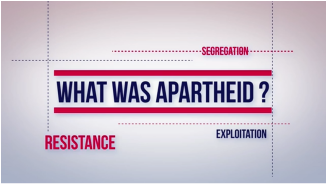 What was apartheid in South Africa? What was apartheid in South Africa? Tags: capitalism, education, immigration/citizenship, inequality, organizations/occupations/work, political economy, prejudice/discrimination, race/ethnicity, apartheid, racism, south africa, 00 to 05 mins Year: 2013 Length: 2:56 Access: YouTube Summary: In this short video from Al Jazeera's AJ+ web series, host Francesca Fiorentini provides a brief history of apartheid in South Africa. As Fiorentini explains, apartheid is an Afrikaans word that means separateness, but it came to represent a formal system of racial segregation that governed South Africa for nearly 50 years. People were classified by the categories "white," "black," "Indian," and a fourth category, "colored," which designated people of mixed race. Using this classification system, people were separated into different residential areas called homelands, which were typically rural, poor, and overcrowded. The movement of blacks outside of their homelands was tightly controlled through the pass laws. Under these laws, blacks had to carry permits at all times and obey strict curfews. Schools for blacks were underfunded, and in a system seemingly designed to funnel blacks into menial migrant labor, mandatory education for blacks ended at age 13. Lacking stable employment in economically deprived homelands, blacks were pushed to find work as migrant laborers. However, wages were low for such workers, and because it was illegal for them to strike, they had little recourse. As mentioned in this video, it is important not to lose sight of the political economy of apartheid. This system of separateness did not last for 50 years simply because of the deeply held prejudices of white South Africans; instead, apartheid was the edifice upon which South African companies could hang their profits. By upholding the apartheid system, powerful gold mining magnates could legally exploit black workers for deep profit with the consent of the state. Many Americans continue to read the story of apartheid in South Africa as a shameful and unrecognizable relic of ancient history, but the system was still in place as recently as 20 years ago. And while it was the law of the land for 50 years in South Africa, Jim Crow segregation prevailed in the United States for nearly 90 years. The truth is, apartheid is neither ancient nor unfamiliar to Americans. Note that another video on The Sociological Cinema explores the striking similarities between racial inequality in South Africa and the United States, and this Pinterest board explores the anti-apartheid movement. Submitted By: Lester Andrist 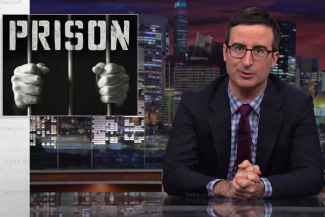 John Oliver breaks down the problems with American prisons John Oliver breaks down the problems with American prisons Tags: crime/law/deviance, inequality, political economy, prejudice/discrimination, race/ethnicity, violence, criminal justice system, incarceration, prison, prison industrial complex, racism, sexual assault, 11 to 20 mins Year: 2014 Length: 17:42 Access: YouTube Summary: In the United States, nearly 1 in every 100 adults are now in prison or jail, meaning that the U.S.incarcerates more people than those regimes Americans typically regard as repressive, such as China and Russia. Why are there so many people in American prisons? In this video from Last Week Tonight, John Oliver explains that 50% of the male prisoners in federal prisons and about 58% of female prisoners are there as a result of drug offenses. The same is true for 25.4% of all prisoners in state prisons. Given other posts on The Sociological Cinema, which explore racism in the criminal justice system (here, here and here), it may come as little surprise that a disproportionate number of prisoners are black and Latino, even when controlling for education. In fact, Human Rights Watch recently completed a study where they concluded that blacks were 10.1 times more likely to enter prison for drug offenses than whites. One result is that blacks constitute 40% of all prisoners under state jurisdiction, while whites only constitute 29% of all such prisoners. The disproportionate incarceration of blacks for drug offenses is even more striking when one considers that with the exception of crack, whites actually use more illegal drugs than blacks. The video concludes with a review of some of the deplorable conditions prisoners are now forced to endure, due in part to a move toward greater privatization. Oliver discusses the high risk of sexual assault, the small size of cells, maggot-infested food, and substandard healthcare, including an incident of pouring sugar into woman's C-section incision as a substitute for antibiotics. In another post, I have explored the fact that between 2006 and 2010, at least 148 women in California prisons were sterilized by doctors under the precepts of a eugenics ideology, a fact which underscores the desperate vulnerability of the bloated U.S. prison population. Submitted By: Lester Andrist 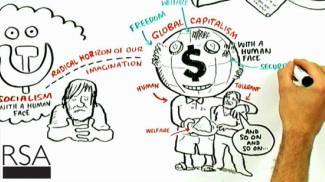 Žižek argues charitable consumption prolongs capitalism's ills. Žižek argues charitable consumption prolongs capitalism's ills. Tags: capitalism, consumption/consumerism, corporations, culture, economic sociology, marketing/brands, marx/marxism, political economy, theory, charity, corporate social responsibility, cultural capitalism, morality, starbucks, žižek, 06 to 10 mins Year: 2010 Length: 10:56 Access: YouTube Summary: In this animated segment of a longer lecture, Slavoj Žižek critiques the cultural dimensions of contemporary capitalism. Žižek begins by stating how capitalism has changed from a dichotomy between production and traditional charity (e.g. Soros earns money by exploiting workers then gives it back to humanist causes), to a form of capitalism that brings the dimensions of morality and consumption together. He offers several examples of this "cultural capitalism," including Starbucks and Tom's Shoes. In each of these instances, the act of consumption and doing good are part of the same process, which has now been universalized throughout capitalism. It is meant to make people (i.e. consumers) feel good about themselves in that they are helping poor people or a degraded environment. However, Žižek argues that by participating in this system, consumers are actually "prolonging the disease ... rather than curing it." He promotes changing the structure rather than this sort of charitable act: "The proper aim is to try and reconstruct society on such a basis that poverty would be impossible and the altruistic virtues have really prevented the carrying out of this aim." He compares this system to slave owners who were kind to their slaves because they prevented oppressed slaves from realizing the core injustice of slavery; in other words, it suggests that we are doing enough to address the system's ills and prevents more significant change. While there is an implicit argument to do away with capitalism here, Žižek explicitly states that 20th century socialism was a "mega catastrophe" and does not promote a return to that system. The clip also works well to initiate critical discussions of corporate social responsibility, Fair Trade, and other social certifications, and begin to imagine what more radical alternatives might look like. Submitted By: Paul Dean 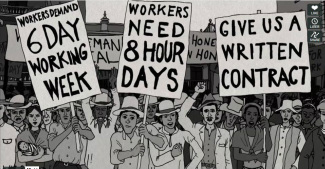 Columbian banana workers demand basic labor rights. Columbian banana workers demand basic labor rights. Tags: capitalism, class, economic sociology, government/the state, historical sociology, inequality, organizations/occupations/work, political economy, social mvmts/social change/resistance, theory, violence, war/military, ideology, labor, neocolonialism, postcolonialism, postcolonial theory, propaganda, 00 to 05 mins Year: 2013 Length: 2:43 Access: Vimeo Summary: This animated excerpt comes from the documentary, "Banana Land: Blood, Bullets and Poison." The clip recounts the events of December 6, 1928, when Colombian workers gathered to the protest the conditions of their employment under the United Fruit Company (UFC), which is now known as Chiquita. As the film explains, by the early twentieth century UFC had become a powerful multinational corporation, and in exchange for its role in helping to prop up repressive regimes in Latin America, the company was afforded cheap land, and in time, it came to develop a monopoly on the transport of fruit in the region. When workers organized to demand better working conditions, including 6-day work weeks, 8-hour work days, money instead of scrip, and written contracts, they were met with a violent response from the Colombian military. Protecting the interests of American economic elites, the United States government threatened to invade Colombia in order to quell the UFC worker protests, and in response, the Colombian government dispatched a regiment from its own army to do the job. The Colombian troops effectively created a kill box, setting their machine guns on the roofs surrounding the plaza where a group of protestors had gathered. After a five-minute warning to disperse, the troops opened fire killing women, men, and children. Other than a sobering reminder of the power corporations often wield over the lives of workers, especially when they have the backing of states, this clip would work well as a means of introducing some of the basic components of postcolonial theory, which can be understood as a body of thought that critiques and aims to transcend the structures supportive of Western colonialism and its legacies. In contrast to Marxist dependency theories and the world systems perspective, work in the postcolonial tradition tends to emphasize cultural, ideological, and even psychological structures born from the forceful and global expansions and occupations of Western empires (Go 2012). The banana strike and its violent conclusion is a vivid example of the way the United States has maintained a postcolonial grip on the running of foreign economies. In this case, a propaganda machine chipped away at international sympathy for the protesting workers, while at the same time, the U.S. was able to wield power over the Colombian government by mere threat of military force. Submitted By: Lester Andrist 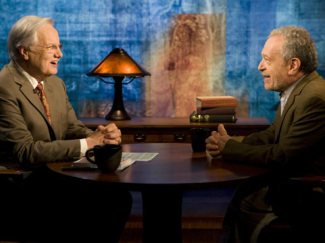 Robert Reich discusses economic inequality with Bill Moyers Robert Reich discusses economic inequality with Bill Moyers Tags: capitalism, class, consumption/consumerism, corporations, crime/law/deviance, economic sociology, globalization, government/the state, inequality, organizations/occupations/work, political economy, politics/election/voting, science/technology, robert reich, social mobility, subtitles/CC, 21 to 60 mins Year: 2013 Length: 56:46 Access: Moyers & Company Summary: In this interview on Moyers & Company, former Secretary of Labor and professor of public policy at the University of California in Berkeley, Robert Reich discusses economic inequality and the worrisome connection between money and political power. Reich notes that "Of all developed nations, the US has the most unequal distribution of income," but US society has not always been so unequal. At about the 6:20 mark, the clip features an animated scene from Reich's upcoming documentary, Inequality for All, which illustrates that in 1978 an average male worker could expect to earn $48,302, while an average person in the top 1% earned $393,682. By 2010, however, an average worker was only earning $33,751, while the average person in the top 1% earned $1,101,089. Wealth disparities have also been growing, and here Reich explains that the richest 400 Americans now have more wealth than the bottom 150 million Americans. What happened in the late 1970s to account for the current trend of widening inequality? According to Reich, there are four culprits. First (at about 19:10 min), a powerful corporate lobbying machine has successfully lobbied for laws and policies that have allowed for wealthy people to become even more wealthy, often at the expense of the poor. Examples include changes to antitrust, bankruptcy, and tax legislation. Second (at 34:00 min), Reich argues that unions and popular labor movements have been on the decline, which means employers have been under less pressure to increase wages over time. Third (at 38:30 min), while globalization hasn't reduced the number of jobs in the US, it has meant that employers often have access to cheaper labor, which has had the effect of driving down wages for American workers. He points out that in the 1970s, meat packers were paid $40,599 each year. Now they only earn $24,190. Fourth (at 38:30 min), technological changes, such as automation, have had the effect of keeping wages low. He concludes that there is neither equality of opportunity nor equality of outcome in the U.S., and unless big money can be separated from politics, the U.S. economy is unlikely to free itself from this viscous cycle of widening inequality for all (Note that a much shorter video featuring Reich's basic argument is also located on The Sociological Cinema). Submitted By: Lester Andrist 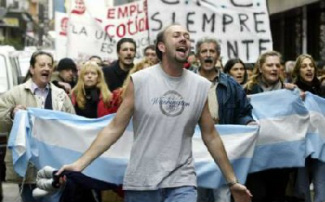 Argentinians protest economic policies of the IMF. Argentinians protest economic policies of the IMF. Tags: capitalism, economic sociology, globalization, political economy, social mvmts/social change/resistance, theory, argentina, deregulation, double-movement, embeddedness, karl polanyi, laissez-faire capitalism, neoliberalism, regulation, subtitles/CC, 00 to 05 mins Year: 2004 Length: 5:30 Access: YouTube (start 3:05; end 8:35) Summary: In his famous book, The Great Transformation, Karl Polanyi argued that, throughout human history, economic decisions have always been embedded within society (i.e., they have been shaped and constrained by social values and relationships). However, with contemporary capitalism, the economy has become disembedded from society through laissez-faire capitalism, which is promoted by many liberal economists and capitalists, and meant to disregard social factors. While this system has created tremendous wealth, it is unable to regulate itself and is not a "natural" economic order, as its proponents claim. In actuality, if laissez-faire capitalism is left to itself, it creates so much social dislocation that it would destroy itself, and thus it inevitably sparks resistance to it. This resistance leads to movements to regulate capitalism to varying degrees, from reforms that put constraints on capitalism (e.g., the New Deal) to more radical changes to the capitalist structure (e.g., socializing the economy through a centralized state), thus re-embedding the economy within society. This excerpt from the documentary, The Take (start 3:05; end 8:35), illustrates this double-movement between efforts at regulation and de-regulation. With a focus on Argentina, it shows how systematic deregulation in the 1990s, and the problems it created, sparked massive resistance. The deregulation (which itself required state action) included selling off public assets, eliminating currency controls, and implementing a variety of business-friendly policies. Supported by the IMF, these neoliberal policies crashed the economy in 2001, resulting in massive unemployment and poverty rates exceeding 50%, which sparked spontaneous protests throughout the country. Like similar double-movements throughout the world, the resistance sought to re-regulate the economy, and re-embed the economy in society, to meet vital social needs. The rest of the documentary shows that, in this case, the social response included a movement of workers that occupied and began running factories on their own. Submitted By: Paul Dean 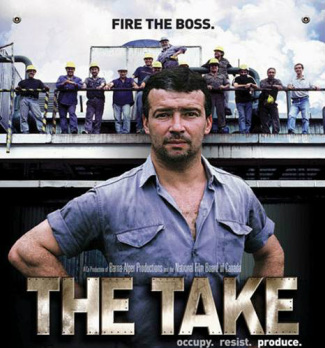 The Take documents factory takeovers in Argentina. The Take documents factory takeovers in Argentina. Tags: capitalism, class, economic sociology, globalization, marx/marxism, organizations/occupations/work, political economy, social movements/social change/resistance, theory, factory takeovers, labor, occupy, real utopias, worker cooperatives, subtitles/CC, 61+ mins Year: 2004 Length: 87:00 Access: YouTube Summary: This excellent documentary from Naomi Klein and Avi Lewis documents the extraordinary movement of factory takeovers in Argentina. As noted on the The Take's website, "In the wake of Argentina's dramatic economic collapse in 2001, Latin America's most prosperous middle class finds itself in a ghost town of abandoned factories and mass unemployment. The Forja auto plant lies dormant until its former employees take action. They're part of a daring new movement of workers who are occupying bankrupt businesses and creating jobs in the ruins of the failed system." By following the struggle of the Forja workers to regain control over its factory, it shows how workers formed networks and coalitions in their movement, the legal context of recuperated factories, the different organizational structures that workers develop to run their factories, the political reaction to neoliberalism, and the electoral race to shape Argentina's future. Accordingly, the movement serves as a unique bottom-up alternative to neoliberal capitalism. The film offers excellent illustrations of several sociological concepts, such as class consciousness and ideology. It also reflects Erik Olin Wright's concept of real utopias, which are "utopian ideals that are grounded in the real potentials of humanity ... [including] utopian designs of institution that can inform our practical tasks of navigating a world of imperfect conditions for social change" (2010: 6). As a "real utopia," the recuperated factories represent actually existing social projects that embody ideals of social justice, equality, and participatory democracy--they are not perfect (no social projects are), but they can serve as one model (of many) for what is possible. While the documentary was released in 2004, viewers may be interested to know that the movement of recovered factories continues in Argentina, including hundreds of workplaces and over 10,000 workers. For books on the movement of worker-run factories in Argentina, see Sin Patrón (2007) and The Silent Change (2009). There is also a recent (2013) example of one such factory in the US, Chicago's New Era Windows Cooperative. Submitted By: Paul Dean 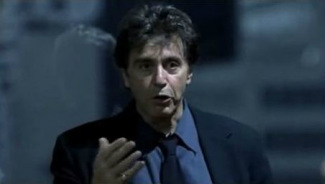 Al Pacino tries to save his story from corporate censorship. Al Pacino tries to save his story from corporate censorship. Tags: capitalism, corporations, knowledge, marx/marxism, media, political economy, theory, censorship, fox, ideology, monsanto, news, 00 to 05 mins, 06 to 10 mins Year: 2003; 1999 Length: 10:20; 4:17 Access: YouTube (clip from The Corporation) YouTube (clip from The Insider) Summary: This pair of excerpts exposes corporate censorship of the news via a documentary (The Corporation) and through a Hollywood film (The Insider). In recent years, the news media has become increasingly concentrated and controlled by corporations. The implications of this is that corporations are responsible to shareholders and must earn high profits. This concentration of corporate news has led to conflicts of interests when a news source wants to air a story that could hurt their advertisers or their shareholders. The first clip from The Corporation shows this process. In 1997, investigative journalists Steve Wilson and Jane Akre of Fox News, had prepared a story about Monsanto and the negative impacts of their bovine growth hormones (e.g. their milk was potentially carcinogenic to humans). Monsanto was an advertiser for the Fox News channel, and the company threatened to both sue Fox and pull their ads. Because this would have cost Fox News significant advertising revenues, Fox decided to edit the news story so Monsanto would not pull their ads. The clip describes the process of 83 rewrites that either removed or minimized any negative effects of the hormone, until the journalists were ultimately fired and the story never aired. The second clip, from The Insider, features Al Pacino arguing how a story at 60 Minutes was being censored because of financial interests. The film is based on a true story about a whistle blower who worked for Big Tobacco and CBS was hesitant to air the interview on 60 Minutes because it might jeopardize the sale of CBS to Westinghouse Electric. Both clips illustrate the political economy of news media and Marx's concept of ideology, in which ideas and knowledge reflect the interest of the ruling class. Marx argues that the class having the means of material production (e.g. technology, money, labor, tools, etc.) also has control over the means of intellectual production (newspapers, schools, books, broadcast media, etc). One can see Marx’s claim come to life with the influence that Monsanto had over Fox News. Corporate interests shaped what news was aired, and a Fox executive later told the journalists "the news is what we say it is"; when the journalists used the courts to fight back, a Florida appeals court ruled that falsifying the news is not against the law. In both cases, financial interests shaped what constituted the news, and how it was presented--ultimately shaping knowledge in the interest of the dominant class. Submitted By: Avery Winston and Paul Dean |
Tags
All
.
Got any videos?
Are you finding useful videos for your classes? Do you have good videos you use in your own classes? Please consider submitting your videos here and helping us build our database!
|
 RSS Feed
RSS Feed
